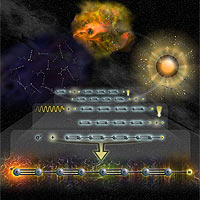
Astronomers using data from the National Science Foundation's Robert C. Byrd Green Bank Telescope (GBT) have found the largest negatively-charged molecule yet seen in space. The discovery of the third negatively-charged molecule, called an anion, in less than a year and the size of the latest anion will force a drastic revision of theoretical models of interstellar chemistry, the astronomers say.
"This discovery continues to add to the diversity and complexity that is already seen in the chemistry of interstellar space," said Anthony J. Remijan of the National Radio Astronomy Observatory (NRAO). "It also adds to the number of paths available for making the complex organic molecules and other large molecular species that may be precursors to life in the giant clouds from which stars and planets are formed," he added.
A team of scientists from the Harvard-Smithsonian Center for Astrophysics (CfA) found negatively-charged octatetraynyl in a cold, dark cloud of molecular gas. A second team headed by Remijan found octatetraynyl in the envelope of gas around an old, evolved star. In both cases the molecule, a chain of eight carbon atoms and one hydrogen atom, had an extra electron, giving it a negative charge.
About 130 neutral and about a dozen positively-charged molecules have been discovered in space, but the first negatively-charged molecule was not discovered until late last year. The largest previously-discovered negative ion found in space has six carbon atoms and one hydrogen atom.
Ultraviolet light from stars can knock an electron off a molecule, creating a positively-charged ion. Astronomers had thought that molecules would not be able to retain an extra electron, and thus a negative charge, in interstellar space for a significant time. "That obviously is not the case," said Mike McCarthy of the CfA. "Anions are surprisingly abundant in these regions."
"Until recently, many theoretical models of how chemical reactions evolve in interstellar space have largely neglected the presence of anions. This can no longer be the case, and this means that there are many more ways to build large organic molecules in cosmic environments than have been explored," said Jan M. Hollis of NASA's Goddard Space Flight Center (GSFC).
Remijan and his colleagues found the octatetraynyl anions in the envelope of the evolved giant star IRC +10 216, about 550 light-years from Earth in the constellation Leo. They found radio waves emitted at specific frequencies characteristic of the charged molecule by searching archival data from the GBT, the largest fully-steerable radio telescope in the world.
Another team from the Harvard-Smithsonian Center for Astrophysics found the same characteristic emission when they observed a cold cloud of molecular gas called TMC-1 in the constellation Taurus. These observations also were done with the GBT. In both cases, preceding laboratory experiments by the CfA team showed which radio frequencies actually are emitted by the molecule, and thus told the astronomers what to look for.
"It is essential that likely interstellar molecule candidates are first studied in laboratory experiments so that the radio frequencies they can emit are known in advance of an astronomical observation," said Frank Lovas of the National Institute of Standards and Technology (NIST).
Both teams announced their results in the July 20 edition of the Astrophysical Journal Letters.
"With three negatively-charged molecules now found in a short period of time, and in very different environments, it appears that many more probably exist. We believe that we can discover more new species using very sensitive and advanced radio telescopes such as the GBT, once they have been characterized in the laboratory," said Sandra Bruenken of the CfA.
"Further detailed studies of anions, including astronomical observations, laboratory studies, and theoretical calculations, will allow us to use them to reveal new information about the physical and chemical processes going on in interstellar space," said Martin Cordiner, of Queen's University in Belfast, Northern Ireland.
"The GBT continues to take a leading role in discovering, identifying and mapping the distribution of the largest molecules ever found in astronomical environments and will continue to do so for the next several decades," said Phil Jewell of NRAO.
In addition to Hollis, Lovas, Cordiner and Jewell, Remijan worked with Tom Millar of Queen's University in Belfast, Northern Ireland, and Andrew Markwick-Kemper of the University of Manchester in the UK.
Bruenken worked with McCarthy, Harshal Gupta, Carl Gottlieb, and Patrick Thaddeus, all of the Harvard-Smithsonian Center for Astrophysics.
The National Radio Astronomy Observatory is a facility of the National Science Foundation, operated under cooperative agreement by Associated Universities, Inc.
MORE NEWS.....
Astronomers have detected negatively charged molecules in space for the first time, suggesting the molecules may be more common than previously thought.
Previously, about 130 different neutral molecules and 14 positively charged molecules had been identified in space - but no negatively charged molecules were found.
Conventional wisdom held that these were rare because ultraviolet radiation from starlight would tend to strip away extra electrons, leaving behind only positive ions.
Now, astronomers from the Harvard-Smithsonian Center for Astrophysics (CfA) in Cambridge, Massachusetts, US, have found a negatively charged molecule in two nearby regions within the Milky Way. Composed of six carbon atoms, a hydrogen atom, and an extra electron, it is called a hexatriyne anion, or C6H-.
Curiously, the anion was found in two very different environments - a gas shell around the dying, red giant star IRC+10216 and the cold molecular cloud TMC-1, both of which lie about 500 light years from Earth.
Unknown cause
It is not yet clear what physical process actually led to the molecule's formation in those locations. "That's the point we're desperately eager to find out," says team member Patrick Thaddeus of the CfA.
The molecule may have formed in these gaseous regions after an extra proton was bumped off the neutral molecule hexatriyne, C6H2, or by an electron attaching to the neutral molecule C6H. The anion is present in both sources at a level of between 1% and 5% that of the neutral molecule C6H.
One clue to its formation may come from its size; C6H- is composed of more atoms than many of the neutral molecules that have been found in space.
"It was considered crazy that the first negatively charged molecule we found in space would be such a big molecule," Thaddeus says.
This large size may increase the molecule's stability. Previous research suggests electrons can attach themselves quite efficiently to carbon molecules when the molecules are composed of at least six carbon atoms.
Lurking undetected
To make the find, the CfA astronomers pored over data collected 11 years ago by Kentarou Kawaguchi at Okayama University in Japan. Kawaguchi's team found a series of spectral lines that could not be assigned to any known molecule in IRC+10216.
Back in the lab, the CfA team found the spectral lines matched C6H-. They then used the Green Bank Telescope to verify that the molecule was present in the red giant and in TMC-1.
The find suggests other negatively charged molecules are lurking in space and have not been detected because previous searches have focused on more diffuse gas clouds where the anions are not concentrated enough to produce a signal.
"This is a whole area of astrochemistry that we've just kind of been missing," says Robert McMahon, a chemist at the University of Wisconsin, Madison, US, who was not involved in the study.
Team member Michael McCarthy of the CfA says the researchers will search them out by first studying the spectral signatures of large anions, like C6H-, in the laboratory.
They have already found C4H- and C8H- in the lab and are now trying to find the molecules' signatures in space. The team says they may find these anions in IRC+10216 and TMC-1, since neutral or positively charged variations of these molecules have already been observed in the regions.
Technorati : Discovered, Molecule, Negatively-, New







